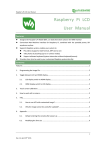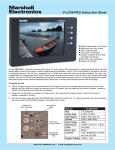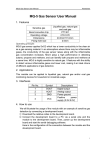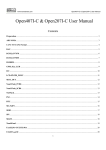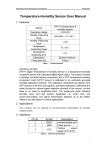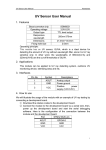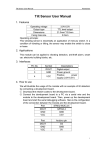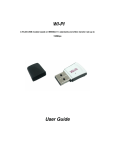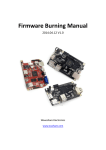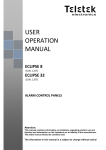Download RPi LCD User Manual
Transcript
RPi LCD User Manual Waveshare RPi LCD User Manual Features Designed for Raspberry Pi Model B/B+, an ideal alternative solution for HDMI monitor Convenient Men-Machine interface for Raspberry Pi, combined with the portable power, DIY anywhere anytime Supports Raspbian system, enables your system to: Play videos (supports multi formats, MP4 and so on) Take photos by touching (up to 17 camera modes) Support software keyboard (system interaction without keyboard/mouse) Contents RPi LCD User Manual ................................................................................................................ 1 Features ........................................................................................................................... 1 1. 2. 3. Programming the image file ....................................................................................... 2 LCD display switch to HDMI display....................................................................... 3 HDMI display switch to LCD display....................................................................... 3 4. Touch screen calibration ......................................................................................... 3 5. 6. How to work with a camera ..................................................................................... 4 Appendix.................................................................................................................. 5 6.1 Default entering the console after power up ........................................... 5 6.2 Modifying the LCD screen resolution....................................................... 5 1 RPi LCD User Manual Waveshare 1. Programming the image file 1) RPi LCD needs to use a SPI interface, but in the original image file of Raspberry Pi, the displayer is driven via a HDMI port. So the original image is not applicable for RPi LCD, and you should use the system image file provided by Waveshare. 2) The image file provided by Waveshare is located at the directory of IMAGE in the CD provided with the product (for more information about how to programming the image file, please refer to the document Writing IMG files to SD Card). When finished the programming, please power on the module, and wait more than 30 secs. Then, you will see the boot screen of Raspbian shown in the LCD and enter the desktop of the system. Descriptions: Under LCD display mode, the screen touch function is available. For data inputting, you can click the start menu in the bottom-left of the screen, and select Accessories->Keyboard, to enable the Virtual Keyboard for command inputting, as Figure 1 shows. Figure 1: Enabling the virtual keyboard 2 RPi LCD User Manual Waveshare 2. LCD display switch to HDMI display 1) The default boot mode of the system image in CD selects LCD display. And there will be no output to the external HDMI displayer if you apply one under this mode. In case that you want to use HDMI display, please execute the following commands: 2) pi@raspberrypi:/$ sudo su root@raspberrypi:/# HDMI-SYS-SHOW The system will load the driver (wait several minutes). And the Raspberry Pi will reboot automatically, when the driver loaded. After the module rebooted, waiting more than 30 seconds, there will be information display on the HDMI screen. And then, you will enter into Startx interface. 3. HDMI display switch to LCD display If you need to use LCD display again, please operate the following commands to switch to this mode: pi@raspberrypi:/$sudo su When using 3.2inch RPi LCD, please input: root@raspberrypi:/# LCD32-SYS-SHOW-V3 When using 3.5inch RPi LCD, please input: root@raspberrypi:/# LCD35-SYS-SHOW When using 4nch RPi LCD, please input: root@raspberrypi:/# LCD4-SYS-SHOW When finished the commands above, the system will load the driver (wait several minutes). And the Raspberry Pi will reboot automatically, when the driver download finished. After the module rebooted, waiting more than 30 seconds, there will be information display on the HDMI screen. And then, you will enter into system interface. Descriptions: Under the HDMI display mode, you should use an external keyboard or SSH method for command inputting, since the virtual keyboard is not available. Or you can set a serial port as a debugging interface for command inputting. 4. Touch screen calibration 1) Enter the following commands for touch screen calibration: pi@raspberrypi:/$ su pi pi@raspberrypi:/$ DISPLAY=:0.0 xinput_calibrator 2) After running these commands, there will be a prompt for four-point calibration shown in the LCD screen. Click the points one by one to finish the touch calibration. Then, the new calibration data will be displayed in the terminal, as 3 RPi LCD User Manual Waveshare Figure 2 shows. Please get these data for future use. Figure 2: The calibration data displayed in the terminal 3) Enter the following command to edit 99-calibration.conf: pi@raspberrypi:/$ sudo nano /etc/X11/xorg.conf.d/99-calibration.conf Figure 3: Editing 99-calibration.conf 4) Modify the data marked with red box in the Figure 3 to the new calibration data displayed in the step 2), as Figure 4 shows. Figure 4: Modifying the data of Option “Calibration” 5) 6) Press the keys Ctrl+X, and select the option Y to save the modification. The modification will be valid after rebooting the system. Enter the following command for system rebooting: pi@raspberrypi:/$ sudo reboot Notices: In case of inaccurate touch, please perform screen calibration again and reboot the system. 5. How to work with a camera RPi LCD can also work with an external camera to take photos. In this operation, a Raspberry Pi camera is required, which should be purchased separately. To work with a camera, you should enter the terminal, and input: cd /home/pi/camera/ Camera 4 RPi LCD User Manual Waveshare Then, waiting several seconds, the camera application will be started automatically. Now, you can capture pictures by double clicking the screen. 6. Appendix 6.1 Default entering the console after power up You can perform more operations to Raspberry Pi module by entering the console of the Raspbain. 1) 2) Edit the file rc.local. you should enter the terminal, and input: sudo nano /etc/rc.local (Eidt the file rc.local) Find out the following line: Add the symbol “#”before this line, as follows: 3) Press the keys Ctrl+X, and select the option Y to save the modification. 4) Reboot the system: sudo reboot After the system rebooted, you will enter the console automatically. 6.2 Modifying the LCD screen resolution Following the steps listed below, you can modify the LCD screen resolution 1) 2) Edit the file rc.local. You should enter the terminal and input: sudo nano /etc/rc.local (Edit the file rc.local) Find out the following line: Modify the figure following the “dpi”. It is suggested to modify to “60”. Although the smaller font size allows more information shown in a screen, 3) the content displayed is less clear as well. Press the keys Ctrl+X and select the option Y to save the modification. 4) Reboot the system: sudo reboot The modification will be valid after the system rebooted. 5





